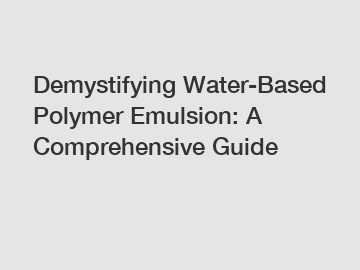Demystifying Water-Based Polymer Emulsion: A Comprehensive Guide
Demystifying Water-Based Polymer Emulsion: A Comprehensive Guide?
Water-based polymer emulsion is a versatile substance used in various industries, from paints and coatings to adhesives and textiles. But what exactly is a water-based polymer emulsion, and how does it work? In this comprehensive guide, we will unravel the complexities of this fascinating material and explore its applications and benefits.
1. What is a water-based polymer emulsion?

A water-based polymer emulsion is a colloidal dispersion of polymer particles in water. It is created by blending water, a polymer, and surfactants to stabilize the emulsion. The polymer particles are extremely tiny, typically ranging from 0.05 to 5 micrometers in diameter. This emulsion has a milky appearance and can be easily mixed with other substances.
2. How does it work?
The emulsion's stability is crucial for its functionality. Surfactants present in the emulsion help to disperse the polymer particles evenly throughout the water, preventing them from clumping together. These surfactants also provide stability by creating a protective barrier around the particles, preventing them from agglomerating or settling.
3. What are the applications of water-based polymer emulsions?
Water-based polymer emulsions find applications in various industries due to their versatility and advantageous properties. Some common applications include:
- Coatings: Water-based polymer emulsions are widely used in coatings, such as architectural paints, industrial coatings, and wood finishes. They provide excellent adhesion, durability, and resistance to chemicals and UV radiation.
- Adhesives: These emulsions serve as the base for water-based adhesives used in paper, textile, and packaging industries. They offer good bonding strength, flexibility, and ease of application.
- Textiles: Water-based polymer emulsions are utilized in textile printing and finishing processes. They provide a smooth and soft hand feel, excellent color fastness, and improve wrinkle resistance.
- Paper: The emulsions are used in paper coatings to enhance print quality, water resistance, and glossiness. They also improve ink penetration and reduce paper dusting.
- Construction: Water-based polymer emulsions find use in construction applications like cement admixtures, tile adhesives, grouts, and sealants. They improve workability, bonding, and mechanical properties of these products.
4. What are the benefits of water-based polymer emulsions?
Water-based polymer emulsions offer numerous advantages over other types of coatings and adhesives:
- Environmental Friendliness: Unlike solvent-based formulations, water-based emulsions have lower Volatile Organic Compound (VOC) content, making them environmentally friendly and safer for human health.
- Easy Application and Clean-Up: Water-based emulsions are easy to apply using common application methods like spraying, brushing, or rolling. They also clean up easily with water, eliminating the need for harsh solvents.
- Improved Safety: Water-based emulsions reduce fire hazards associated with solvent-based products as they have a higher flash point and lower flammability.
- Excellent Performance: These emulsions offer excellent adhesion, flexibility, and durability, making them suitable for a wide range of applications. They also exhibit good resistance to weathering, chemicals, and UV radiation.
In conclusion, water-based polymer emulsions are versatile materials with a wide range of applications and numerous benefits. They offer excellent performance, environmental friendliness, and easy application and clean-up, making them a preferred choice in industries ranging from paints and coatings to adhesives and textiles. By understanding the fundamental properties and applications of water-based polymer emulsions, you can unlock their full potential and make informed decisions when choosing the right material for your specific needs.
For more What is SBR latex used for?, nbr latex, styrene acrylic emulsion for wall coatinginformation, please contact us. We will provide professional answers.


